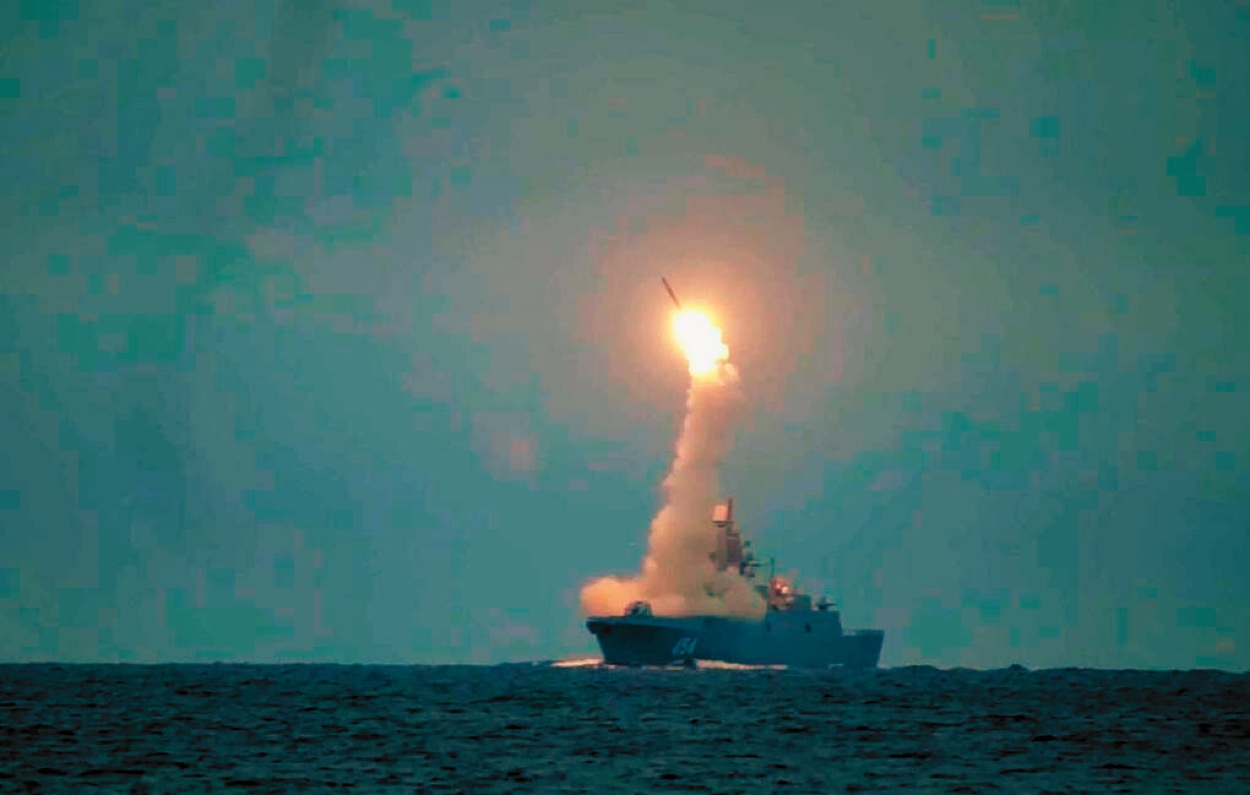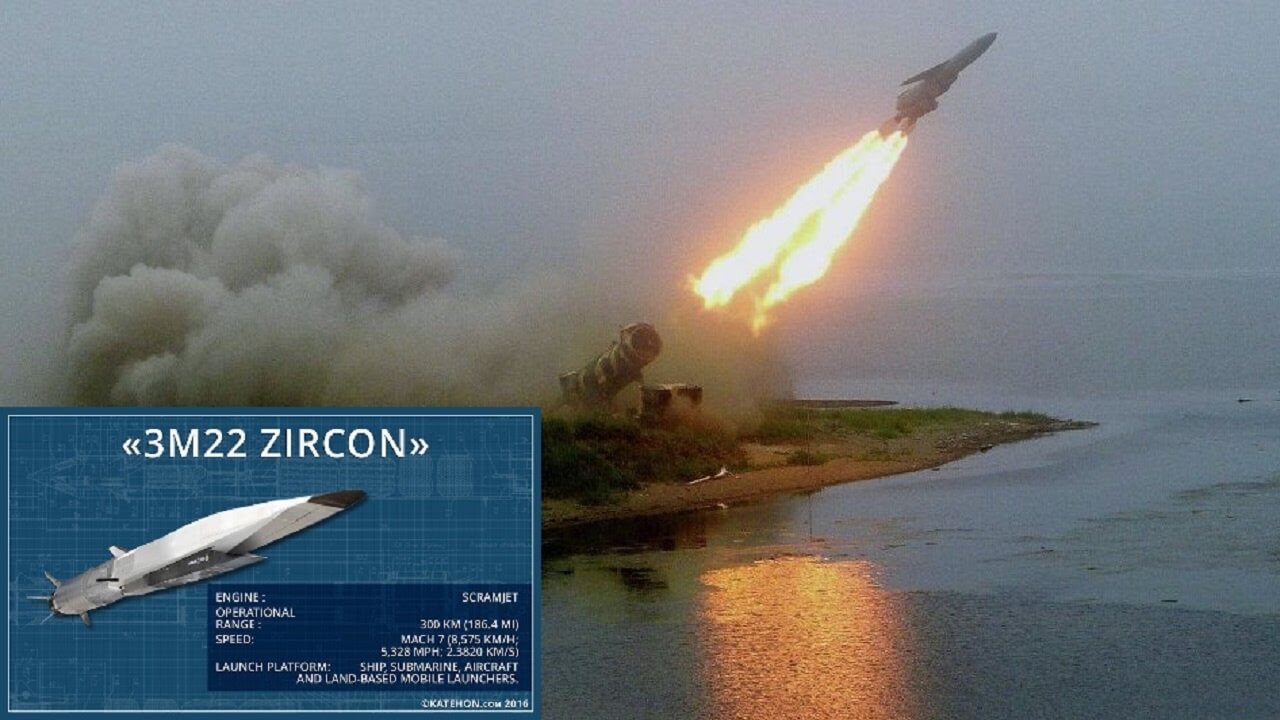Heaping praises on Russia’s sea-based hypersonic missile Zircon (or Tsirkon), the CEO of Tactical Missiles Corporation, Boris Obnosov, said in an interview with Rossiya-24 television that the missile can defeat nearly any air defense system.
“For the time being, the characteristics of the Tsirkon system are extremely high, and, of course, a very effective anti-missile or air defense system is needed to intercept it. To me, at present, Tsirkon is a weapon that allows us to say that we can overcome any enemy defense.”
This assertion made by the CEO is significant as it comes in the wake of the alleged poor performance shown by another Russian hypersonic missile ‘Kinzhal’ in the ongoing Ukraine war.
The air-launched ballistic missile, which was projected as invincible by Russian President Vladimir Putin, has been intercepted and shot down by Western missile defense systems deployed by Ukraine.
Earlier this month, when Russia carried out one of its most significant missile attacks on Kyiv, the Ukrainian Air Force announced that its air defense troops had managed to shoot down all ten Kh-47M2 Kinzhal hypersonic missiles launched from MiG-31K aircraft on January 2.
A few days later, it also claimed to have recovered the downed but unexploded warhead.
This was not, however, the first time that Ukrainian officials have claimed the downing of Kinzhal missiles. The Ukrainian Ministry of Defense (MoD) announced last year that the Ukrainian troops had shot down a hypersonic missile from Russia in May 2023 using the PAC-3 Patriot missile defense system. Several such interceptions have since been reported.

Although Russia has categorically denied claims of its Kinzhal’s interception by Patriot missile defense systems, it has nonetheless been red-faced by repetitive claims and the visuals published on social media.
It is primarily believed that almost all hypersonic weapons can avoid conventional anti-missile defense systems owing to a low atmospheric-ballistic trajectory. Additionally, since they considerably reduce the time it takes to reach the target and thus reduce the time defenders have to react, hypersonic cruise missiles provide new operational challenges for rival or adversarial forces at sea and on land.
It is due to these formidable advantages of hypersonic weapons that several pro-Ukrainian military analysts and commentators have questioned Russia’s hypersonic weapons and called them a mere hyperbole.
Zircon is not Kinzhal and has never really seen combat. It is a multi-purpose hypersonic missile designed to strike sea and ground targets, has a range of over 1,000 kilometers, and can travel over 10,000 kilometers per hour.
It was in 2020 that Russia first stated that the Zircon had advanced to the mass production stage and even the most sophisticated American defenses wouldn’t be able to stop the missile. Two years later, it launched serial deliveries of Zircon missiles to the Russian Navy in December 2022.
As the battle rages on, the missile is still fitted to advanced Russian vessels. The claim that the missile could not be intercepted is merely a supposition by Russian officials because it has not been tested in combat. However, the sea-launched missile has been hailed as a promising weapon that would pose a severe maritime threat to the West.
Zircon Is Russia’s New Favourite Hypersonic Weapon
Zircon hypersonic cruise missile with scramjet propulsion. Unlike other hypersonic weapons like China’s DF-17 or Russia’s Avangard that use a Hypersonic Glide Vehicle (HGV), hypersonic cruise missiles like Zircon cruise missiles use cooled supersonic combustion ramjet engines, which drive combustion by compressing air flowing at supersonic speeds due to the missile’s forward motion.
Zircon is anticipated to work with the 3S-14 vertical launch system, installed on the Grigorevich and Gorshkov classes, and the Kirov-class cruiser, Admiral Nakhimov, presently undergoing modernization. Besides these frigates, Russia’s quietest submarine, the Yasen-class of subs, will also reportedly be armed with the Zircon.
A prior report suggests that the first Project 885M (Yasen-M) submarine armed with Zircon hypersonic missiles could become operational within the Russian Navy by 2026. With such hypersonic missile-firing capabilities, Russian submarines would substantially challenge the US Navy.
Experts believe that Russian vessels equipped with Zircon hypersonic missiles would challenge the US Navy’s supremacy by endangering its aircraft carriers. Russian military watcher Squadron Leader Vijainder K. Thakur said in this EurAsian Times article, “The hypersonic Zircon will be near impossible to intercept by carrier group air defenses.”

Regarding tactics, a recent RUSI report noted that the Zircon would challenge high-value Western marine platforms and land targets. For instance, a missile traveling at a low altitude of 12–14 nautical miles could be picked up by a destroyer’s radar and electronic support measures (ESM) sensors while at sea.
However, given Zircon’s speed, the said warship would have just over 15 seconds to respond. Such accelerated reaction times may drastically lower the number of missiles required to defeat a surface task group’s air defenses.
Furthermore, the tremendous speed of the Zircon would seem to make it an ideal vector of attack against larger boats since kinetic energy is the single strongest predictor of lethality versus large surface targets (more so than warhead size). The kinetic energy of a hypersonic missile on impact will allow Russia to attack hardened, deep, and ground targets.
The specialists have also, however, advised to take Russian assertions with a pinch of salt. For instance, the RUSI report also delved into the difficulties the missile would face against mobile targets and expressed skepticism about the rocket being fielded by the Russian Navy.
As Russia contemplates the deployment of Zircon-equipped frigates and submarines to far seas, the Zircon may be used to create effective deterrence with the United States and other NATO members. The CEO’s remarks indeed come at an opportune moment.
- Contact the author at sakshi.tiwari9555 (at) gmail.com
- Follow EurAsian Times on Google News




